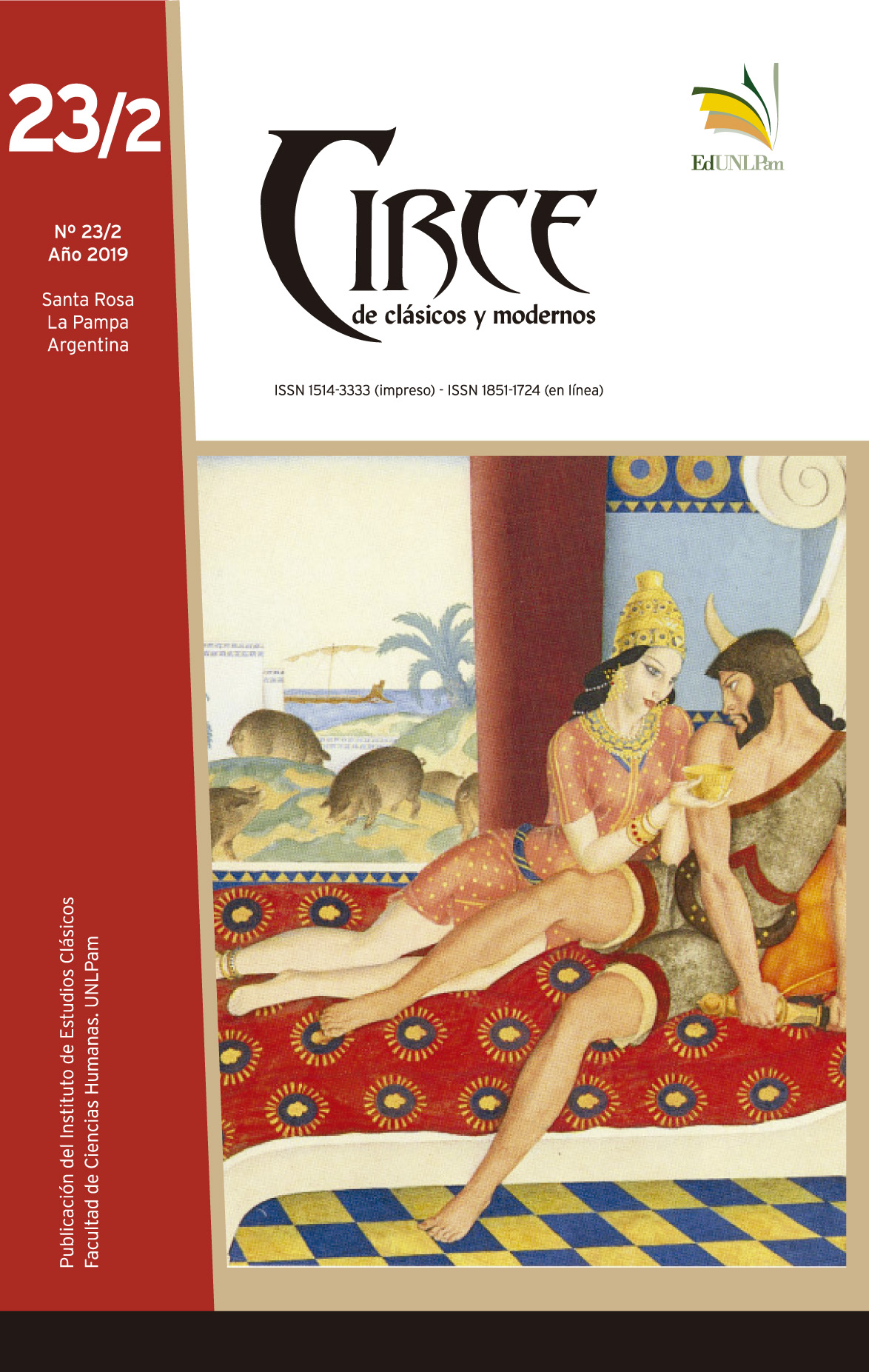El funus romanorum en la Eneida: un análisis de los funerales heroicos de Miseno, Anquises y Palante
Palabras clave:
muerte, funeral, romano, símbolo, apoteosisResumen
Este trabajo analiza qué importancia tiene realizar dignamente el funus romanorum, a partir de los pasajes de la Eneida en los que se muestran las honras fúnebres de tres personajes importantes: a) Miseno, del que se analizará el problema que representaba, en el mundo romano, tanto para los vivos como para los muertos, el permanecer insepulto y la contaminación que la muerte trae consigo para quienes tienen contacto con el cadáver; b) Anquises y el culto a sus Manes y la importancia que poseía dicha actividad, no solo en la Eneida, sino en todo Roma, y del que se afirma en este trabajo que el culto a sus Manes no solo adquiere una importancia fundamental a nivel oracular, sino que se prefigura como principio de las futuras apoteosis romanas; c) las exequias de Palante, que se destacan por el boato con las que son realizadas, la consideración de la finitud del héroe y el carácter simbólico que poseen.
Descargas
Citas
Bautista Calvo, J. (ed.) (1994). Cicerón. Filípicas. Barcelona: Planeta.
Fontán Barreiro, R. (trad.) (1990). Virgilio. Eneida. Madrid: Alianza.
Mynors, R. A. B. (ed.). (1969). P. Vergili Maronis Opera. Oxford: Oxford University Press.
Bibliografía crítica citada
Bayet, J. (1986). La Religion Romana. Historia Política y Psicología. Madrid: Cristiandad.
Eliade, M. (1974). Tratado de historia de las religiones. Madrid: Cristiandad. Eliade, M. (1998). Lo sagrado y lo profano. Barcelona: Paidós.
Gheerbrant, A. & Chevalier, J. (2009). Diccionario de los símbolos. Barcelona: Herder.
Hope, V. (2007). Death in ancient Rome: a sourcebook. London: Routledge. Lewis, C. T., Freund, W., & Short, C. (1969). A Latin dictionary: founded on Andrews’ edition of Freund’s Latin dictionary. Oxford: Clarendon Press.
Lindsay, H. (2004). Death-Pollution and Funerals in the City of Rome en Hope, V. y Marshall, E. (eds.). Death and Disease in the Ancient City. London: Routledge; 152-173.
Meslin, M. (2001). L‘Homme Romain. Des Origines au Ier Siècle de Notre Ère. Paris: Complexe.
Grimal, P. (2008). Diccionario de mitología griega y romana, Barcelona: Paidós.
Price, S. (1996). “From noble funerals to divine cult: the consecration of Roman Emperors” en Cannadine, D. & Price, S. (1996). Rituals of Royalty.
Power and Ceremonial in Traditional Societies. Cambridge: University Press; 56-105.
Rohde. E. (2009) Psique: La idea del alma y la inmortalidad entre los griegos. Madrid: Fondo de Cultura Económica.
Richard, J. (1966). “Tombeaux des empereurs et temples des «divi»: notes sur la signification religieuse des sépultures impériales à Rome”: Revue de l’histoire des religions 170; 127-142.
Toynbee, J. (1996). Death and burial in the roman world. London: Thamer and Hudson.
Vernant, J. P. (2001). El individuo, la muerte y el amor en la antigua Grecia. Barcelona: Paidós.
Publicado
Número
Sección
Licencia
Los autores que tengan publicaciones con esta revista, aceptan los términos siguientes referidos a los derechos de autor/a:
1. Los autores/as conservarán sus derechos de autor y garantizarán a la revista el derecho de primera publicación de su obra, el cuál estará simultáneamente sujeto a la Licencia de reconocimiento de Licencia Creative Commons Atribución-NoComercial-CompartirIgual 4.0 Internacional (http://creativecommons.org/licenses/by-nc-sa/4.0/). que permite a terceros compartir la obra siempre que se indique su autor y su primera publicación esta revista. El autor es el titular del copyright.
2. Los autores/as podrán adoptar otros acuerdos de licencia no exclusiva de distribución de la versión de la obra publicada (postprint) siempre que se indique la publicación inicial en esta revista. La cesión de derechos no exclusivos implica también la autorización por parte de los autores para que el trabajo sea depositado en el repositorio institucional y difundido a través de las bases de datos que el editor considere adecuadas para su indización, con miras a incrementar la visibilidad de la publicación y de sus autores.
3. Se permite y recomienda a los autores/as difundir su obra a través de Internet antes y durante el proceso de envío, lo cual puede producir intercambios interesantes y aumentar las citas de la obra publicada.







.jpg)









2.png)



